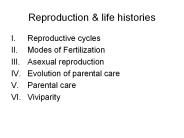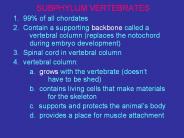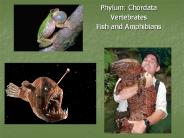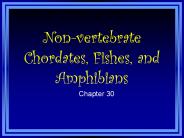Caecilian PowerPoint PPT Presentations
All Time
Recommended
Caecilians are tropical amphibians that look like large worms or slick snakes. ... Inside a caecilian's mouth are dozens of needle-sharp teeth. ...
| PowerPoint PPT presentation | free to view
Figure 5.1 Gill structure in the larvae of viviparous caecilians. Bottom, Dermophis mexicanus (Caeciliidae) with triramous, fimbriated gills; top, Typhlonectes natans ...
| PowerPoint PPT presentation | free to download
CLASS AMPHIBIA Frogs, toads, salamanders, newts, caecilians
| PowerPoint PPT presentation | free to download
Amphibians Class Amphibia Caecilians Are predators Search for earthworms and grubs Have no arms or legs for burrowing, so have to move like an earthworm.
| PowerPoint PPT presentation | free to view
Chapter 25: Vertebrate Diversity Three Groups of Amphibians Caecilians Are legless, burrowing amphibians that live in the tropics. There are 160 species ranging in ...
| PowerPoint PPT presentation | free to download
WELCOME TO HERPETOLOGY. GOAL: To provide students with a basic understanding of the ... Anura: Frogs. Urodela: Caecilians. Urodeles: Caudata: Salamanders ...
| PowerPoint PPT presentation | free to download
Example: Caecilians. Urodela (aka: Caudata) meaning: oura = tail, delos = evident ... Caecilians. 160 species. Only found in tropics. Look like large worms ...
| PowerPoint PPT presentation | free to view
Class Amphibia - amphibians - salamanders, frogs, caecilians (legless animals that burrow) ... Most amphibians rely heavily on moist skin to carry out gas ...
| PowerPoint PPT presentation | free to download
sometimes frogs. garter. garter. They are easily recognized by the stripes running the length of ... C. Frogs and Toads. Caecilians ...
| PowerPoint PPT presentation | free to view
Salientia (Frogs and Toads) Caudata (Salamanders and Newts) Gymnophiona (Caecilians) ... Frog Inner Ear. Photomicrographs. Rana pipiens tympanic membrane ...
| PowerPoint PPT presentation | free to view
The spark: Caecilian was consecrated bishop of Carthage by Felix in 311. The North African bishops rejected Caecilian, and chose first Majorinus and then ...
| PowerPoint PPT presentation | free to view
1) 4 digits on fore-limbs, 5 on rear; caecilians are limbless ... Limbless and elongate (snake-like) Burrow underground; found in tropical rainforests ...
| PowerPoint PPT presentation | free to view
Includes frogs, salamanders, and caecilians ' ... 7/26/09. What is an amphibian? 16. Tadpole. Fish. Caecilian. Frog. No. Yes. Item ...
| PowerPoint PPT presentation | free to view
Why is a song written by many frogs better than a song ... Order Anura (Frogs & Toads) Order Caudata (Salamanders & Newts) Order Gymnophiona (Caecilians) ...
| PowerPoint PPT presentation | free to view
Large-scale conservation priority setting (refining the hotspot approach with ... Salamanders and Newts (Caudata): 352. Caecilians (Gymnophiona): 162. Reptiles (Uetz) ...
| PowerPoint PPT presentation | free to view
Sessile adults filter water with gill slits. Incurrent & excurrent siphons ... Order Anura (frogs & toads) Order Urodela (salamanders) Also caecilians. Amniotes ...
| PowerPoint PPT presentation | free to view
Caecilian is from Latin caecus for blind (as in caecum, a blind ... Couch's Spadefoot Toad. Breeding evoked by the sound of raindrops (how do we know that? ...
| PowerPoint PPT presentation | free to view
They slowly change (metamorphose) into the adult amphibian which lives on land but always near water. Examples of amphibians are the frog and the newt.
| PowerPoint PPT presentation | free to view
... and lacks scales Metamorphose from juvenile water breathing to adult air breathing Ecological indicators Class: Amphibia Order Anura (Salientia): ...
| PowerPoint PPT presentation | free to download
AMPHIBIAN & REPTILE MANAGEMENT General Considerations Habitat Food Regulation Vivarium soil or peat water ... Eastern newt Notophthalmus viridescens ...
| PowerPoint PPT presentation | free to download
Vertebrates in the Sea & on Land Section 32.1 Adaptations of Vertebrates Chordates with a backbone Made of vertebra segments Completely replaces the notochord ...
| PowerPoint PPT presentation | free to download
Amphibians and Reptiles Chapter 5 Powerpoint created & shared by Jamie Miller Fifth & Sixth Grade Teacher Caldwell Adventist Elementary School Idaho Conference, USA
| PowerPoint PPT presentation | free to download
Class: Amphibia Author: Jon and Jen ... Thatch 6_Thatch Zoology Notes Amphibians Quick Question #1 Amphibian basics Tied ... Quick Question #3 Life Cycle How do ...
| PowerPoint PPT presentation | free to download
Animals Vertebrates Vertebrates Five Classes Endoskeleton Support Protect Attachment Notochord Five Classes Fish Amphibians Reptiles Birds Mammals Fish Live in water ...
| PowerPoint PPT presentation | free to download
Class Amphibia Basic Characteristics: Describe the skin. In reference to the skin, what features are they missing that ... Notophthalmus viridescens viridescens ...
| PowerPoint PPT presentation | free to view
Title: PowerPoint Presentation Author: Stacy - McGraw-Hill Higher Education Last modified by: localadmin Created Date: 11/7/2002 3:12:30 PM Document presentation format
| PowerPoint PPT presentation | free to download
We always guide all the Kindle fire users to head Kindle fire support for getting the best lineup of solutions and assistance by the team of professionals. In the case of other problems, just go to Kindle Fire Support to get better guidance. For other queries, just call us.
| PowerPoint PPT presentation | free to download
Amphibians 'having two lives' land and water. General characteristics. smooth, moist skin ... are 3 orders of amphibians. Anura - frogs and toads. Caudata ...
| PowerPoint PPT presentation | free to view
The Vertebrates Vertebrate Characteristics Vertebrae (backbone) Notochord (flexible dorsal rod) Nerve cord (hollow) with brain Three layers of cells as an embryo ...
| PowerPoint PPT presentation | free to view
Reproduction & life histories Reproductive cycles Modes of Fertilization Asexual reproduction Evolution of parental care Parental care Viviparity
| PowerPoint PPT presentation | free to download
General Characteristics First vertebrates on land 4000 species Strong skeleton to support body weight Nostrils for breathing through nose 3 chambered heart Air ...
| PowerPoint PPT presentation | free to download
SUBPHYLUM VERTEBRATES 1. 99% of all chordates 2. Contain a supporting backbone called a vertebral column (replaces the notochord during embryo development)
| PowerPoint PPT presentation | free to download
A giraffe. 7/5/09. What are amphibians? 11. Is this an amphibian? A snake. 7/5/09 ... NO. YES. LIZARD. NO. YES. SNAKE. NO. YES. GIRAFFE. NO. YES. FROG *ITEMS ...
| PowerPoint PPT presentation | free to view
AMPHIBIAN NOTES Excretion and Water Regulaton Amphibians do have kidneys. Their waste product is either ammonia or urea, depending on where they live.
| PowerPoint PPT presentation | free to view
Caudata. Most have internal fertilization, but no copulatory organ. Male ... Caudata. 3 main groups, with distinct evolutionary lineages (distinct clades) ...
| PowerPoint PPT presentation | free to view
... Caudata Distribution Holarctic Aquatic Terrestrial Reproduction Visual displays and olfaction Nasolabial groove Sexual dimorphism Hedonic (scent) glands ...
| PowerPoint PPT presentation | free to download
amphibians holt biology ch. 30 pg. 739-750
| PowerPoint PPT presentation | free to view
PTEROSAURS. DINOSAURS & BIRDS. ARCHOSAURS. CROCODILES. PTEROSAURS. DINOSAURS & BIRDS. 4) CROCODILES. Estuarine Crocodile. What is going to bite me? ...
| PowerPoint PPT presentation | free to view
Northern Water Snake Ringneck Worm Snake Brown Snake Common Garter Snake Plains Garter Snake Ribbon Snake Venomous Snakes of ... From Florida Can reach ...
| PowerPoint PPT presentation | free to download
Phylum: Chordata Vertebrates Fish and Amphibians Vertebrate Characteristics To be in the phylum Chordata you must have these four characteristics at some point in ...
| PowerPoint PPT presentation | free to download
Slide 1 ... amphibians
| PowerPoint PPT presentation | free to download
Tree Frog. Look different. similar skeletal structure. Slender bodies and long legs. Some webbing ... Males have thicker front legs. True Frogs. Vaillant's Frog ...
| PowerPoint PPT presentation | free to view
Overview of Vertebrates Kingdom Animalia Phylum Chordata (Lancelets, tunicates) Sub-Phylum Vertebrata Class Myxini Class Cephalaspidomorphi Class Chondrichthyes
| PowerPoint PPT presentation | free to view
Mouth Esophagus stomach small intestine large intestine cloaca. Respiration ... Cloaca= ammonia primary waste product. Reproduction. Oviparous. Most external ...
| PowerPoint PPT presentation | free to view
TADPOLE hatches. Fishlike frog young. METAMORPHOSIS. Developmental change ... Tadpoles develop legs at 6 weeks. Fully developed at 12 weeks. Able to leave water ...
| PowerPoint PPT presentation | free to view
Almost all amphibians live the first part of their life in water and the ... including grasslands, rain forests, conifer forests, alpine areas, and deserts. ...
| PowerPoint PPT presentation | free to view
Class Amphibia Basic Characteristics: Describe the skin. In reference to the skin, what features are they missing that fish had? What is needed for reproduction?
| PowerPoint PPT presentation | free to download
Overview of the Animal Kingdom CSCOPE CSCOPE Animals are Multicellular Eukaryotic Heterotrophic Cells lack cell walls CSCOPE There are 9 Major Phyla Porifera ...
| PowerPoint PPT presentation | free to view
Non-vertebrate Chordates, Fishes, and Amphibians Chapter 30 Phylum Chordata Contains three sub-phyla: Vertebrata Urochordata Cephalochordata All chordates at some ...
| PowerPoint PPT presentation | free to download
Amphibians and Reptiles Chapter 5 Powerpoint created & shared by Jamie Miller Fifth & Sixth Grade Teacher Caldwell Adventist Elementary School Idaho Conference, USA
| PowerPoint PPT presentation | free to download
They are names that are used for convenience in discussing vertebrate evolution. ... Salientia (Anura) 'Frogs' Urodela (Caudata) 'Salamanders' Tetrapoda: Amniota ...
| PowerPoint PPT presentation | free to view
Some synapomorphies of amniota Slide 23 Slide 24 Synapormorphies of extant Reptilia Slide 26 Anapsids: Testudines (Chelonia) Diapsids Slide 29 Slide 30 ...
| PowerPoint PPT presentation | free to download
Unit 5 Kingdom Animalia Part Three of Notes: Vertebrates*
| PowerPoint PPT presentation | free to download
Animal Kingdom One of 5 Kingdoms what are the others? Invertebrates (8 phyla) Vertebrates = Phylum Chordata Let s start at the very beginning . . .
| PowerPoint PPT presentation | free to view
Vertebrates Phylum Chordata 4 basic characteristics: Notochord supporting rod dorsally located, below the nerve cord, replaced by vertebral column in most ...
| PowerPoint PPT presentation | free to download
Fishes and Amphibians Chapter 30 Biology Auburn High School Pgs. 816 837 30.1: Fishes Pg. 817 826 Characteristics of Fishes Notochord; Gill slits Muscle ...
| PowerPoint PPT presentation | free to view
























































